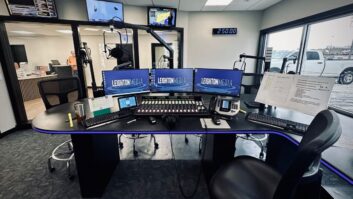John Corbin used to be in the “biz” in Fort Wayne, Ind. He read with interest the tales of Paul Sagi and pulling wire down walls filled with insulation.
(click thumbnail)A clip used to secure wires keeps a ‘greenie’ handy.John worked in both television and radio and was also a former home theater man, so he knows wires, walls and insulation.
John’s recommendation? If you have a lot of wire to pull, or do it frequently, you should look into Greenlee’s Fish Stix. The set consists of either three fiberglass rods, 3 feet long, that thread together, or three rods that are 4 feet long and glow in the dark.
The rods flex nicely, and the set comes with a tip for tying on a pull string or a hook for blind fishing down walls. John has used them frequently in insulated walls; with a little twisting and persuasion, they’ll match any insulated wall.
You can get Fish Stix at Home Depot. The 12 foot set is around $35, the 15 foot set is $45. They’ll probably pay for themselves in labor savings the first time you use them.
If your budget won’t permit a Fish Stix investment, another way to get wires up and down a wall — if there’s nothing in the wall to get in the way — is ball chain.
This is like the chain you find on a pen at the bank or post office. Combine the ball chain with a retracting pick-up magnet and you’re in business.
Most Ace Hardware stores carry ball chain in several diameters, but John says the medium sizes work best. This procedure also works best where you need to put a wire through a small hole, say behind baseboards or behind a speaker. You use the ball chain down the wall and sweep the magnet through the hole to grab the chain.
(click thumbnail)This wire nut on the end of a broken antenna keeps the end from collapsing.MCM Electronics (www.mcmelectronics.com) sells a lot of parts for this purpose under the Labor Saving Devices brand. Enter “Labor Saving Devices” in their search window and have fun with the solutions displayed. You’ll find a flex magnet that John says is excellent (if you don’t flex the magnet off the end!). By the way, MCM also has single six-foot green and luminous push/pull rods for under $30.
Using these techniques saves the GM from hollering about “all the darn holes in the wall” if you have to run wires in public areas around the station. So, not only are these techniques more efficient for you, but there’s an esthetic improvement, too.
* * *
Broadcast Engineer Joe Stack is between contracts; while he’s looking for his next assignment, he took a moment to drop off a couple of great tips for Workbench readers.
The first uses a small adhesive-backed mini wire clip that will attach to the side of a rack or directly onto the front of a rack panel to hold a tweaker, also known as a greenie. I’ve known engineers who buy these by the handful, because they always disappear. These are a “must have” both in the studio and at the transmitter site. See Fig. 1.
Having the tweaker nearby makes for quick adjustments — and if they have a resting place, they won’t get lost. This also means you don’t have to worry about having one on your person at each site you service.
(click thumbnail)Springtime in New England? With an outhouse by the tower?These mini-clips are available at electronic parts stores like RadioShack. Some clips are large enough to hold both a standard greenie and an insulated tool.
Now, here’s a solution to a common problem. Have you ever lost or broken off the screw-on tip from a telescoping radio antenna? The sharp barb that’s left is not only dangerous, but if the end gets pushed down into the next antenna section, it’s almost impossible to get it out.
Enter the wire nut cap. As seen in Fig. 2, this nut cap screwed onto the end of the telescoping antenna will not only protect you from the sharp edge but also keep the antenna from collapsing down into the next barrel.
* * *
Spring is right around the corner. As you study Fig. 3, could that be an AM tower amidst the flora? Perhaps the bigger question is who would build an outhouse next to the tower?
Maybe it has something to do with improved ground conductivity.
Thanks to our anonymous roving contract engineer for sharing a site where his work is cut out for him.















